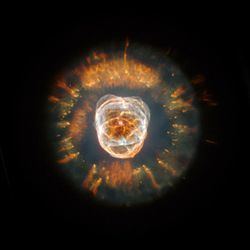Right ascension 07 29 10.7669 Distance ≥2,870 ly (≥880 pc) ly Radius ≥0.34 ly ly Magnitude 10.1 Apparent magnitude (V) 10.1 | Declination +20° 54′ 42.488″ Apparent dimensions (V) 48″ × 48″ Absolute magnitude (V) ≤0.4 | |
 | ||
Similar Cat's Eye Nebula, Engraved Hourglass Nebula, Mz 3, Helix Nebula, Saturn Nebula | ||
Eskimo nebula sheds light on sun s eventual demise video
The Eskimo Nebula (NGC 2392), also known as the Clownface Nebula or Caldwell 39, is a bipolar double-shell planetary nebula (PN). It was discovered by astronomer William Herschel in 1787. The formation resembles a person's head surrounded by a parka hood. It is surrounded by gas that composed the outer layers of a Sun-like star. The visible inner filaments are ejected by a strong wind of particles from the central star. The outer disk contains unusual light-year-long filaments.
Contents
NGC 2392 lies more than 2,870 light-years away and is visible with a small telescope in the constellation of Gemini.
Historic data
The nebula was discovered by William Herschel on January 17, 1787, in Slough, England. He described it as "A star 9th magnitude with a pretty bright middle, nebulosity equally dispersed all around. A very remarkable phenomenon." NGC 2392 WH IV-45 is included in the Astronomical League's Herschel 400 observing program.
